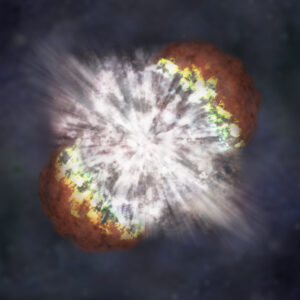Science Seen Physicist and Time One author Colin Gillespie helps you understand your world.
Extreme Physics
In its search for new discoveries physics seeks extremes. Now an inconceivably vast explosion is in the news. What can it teach us?
First let’s be clear about the extremes that physics seeks. They want information about the very small, smaller than atoms for example, and the very large, larger than our Sun and other stars. Both directions—smaller and larger—lead to higher energies that may unveil new theories about how our world works. The news is about observations on the larger side.
The object of interest is called ASASSN-15lh. An international team of astrophysicists used several ground-based telescopes to  observe it. It is a supernova, meaning a single object that shines very brightly for a while. How bright is it? Well, our galaxy, the Milky Way, contains maybe a trillion stars. For weeks ASASSN-15lh gave off up to fifty times more light than the entire Milky Way. (The image doesn’t do it justice; but no image can.) It is in another galaxy, far from our own. Indeed it is so far away that its few weeks’ flare-up happened almost four billion years ago and its light just arrived.
observe it. It is a supernova, meaning a single object that shines very brightly for a while. How bright is it? Well, our galaxy, the Milky Way, contains maybe a trillion stars. For weeks ASASSN-15lh gave off up to fifty times more light than the entire Milky Way. (The image doesn’t do it justice; but no image can.) It is in another galaxy, far from our own. Indeed it is so far away that its few weeks’ flare-up happened almost four billion years ago and its light just arrived.
So how come those astrophysicists were looking at exactly the right place at the right time? The robotic telescopes of the All Sky Automated Survey for SuperNovae scan the sky for such events every two days and set off an alarm, sometimes a false one. This time they found a doozie. Its peak energy emission was twice as bright as the most energetic supernova ever seen before. If this event had happened nearby in our galaxy its radiation could have sterilized the Earth soon after life got underway.
This event is cause for more than an entry in the Guinness World Records. It compels us to ask: How can a single object emit as much light as fifty trillion stars? This is the big science payoff from this super-supernova. Its energy is so extreme this question’s difficult to answer. It tells us we don’t really know what’s going on. The authors say simply: ‘The power source for ASASSN-15lh is unknown.’
The universe has many ways to make extreme eruptions of energy. Stars can suddenly collapse when they can no longer support their weight under their own gravity—leading to a long drop of a huge mass to a hard impact. Or they can cook up lots of an unstable isotope (nickel-56) that decays rapidly. But common mechanisms seem unable to explain ASASSN-15lh.
The favoured possibility is called a magnetar, a fast-spinning compressed star remnant. Think of it like this: A star rotates and it has a magnetic field. The star’s magnetic field whips through surrounding gas as it rotates. Now think of a collapsing star like a spinning ballerina; as she brings in her arms she spins faster. A star larger than a million kilometers collapsing down to less than ten kilometers is a far faster spinner. But it has a maximum possible rate of spin, about a thousand revolutions per second. This sets a maximum total energy a magnetar can have available to dissipate.
ASASSN-15lh gave off that much energy in four months. Maybe it is exceeding the maximum. Thus the most exciting possibility is that ongoing observations of this supernova could rule out all known mechanisms. If so, we will learn something that’s entirely new. That’s the value of extremes in physics. And even more is in the offing. Those astrophysicists look forward to the October, 2018, launch of the James Webb Space Telescope. They say with the JWST they should see events like this back to the time when the first stars were forming after the birth of the universe. Speaking of extremes, those stars will be enormous. Stay tuned.
Sources:
Subo Dong et al. (2016), “ASASSN-15lh: A highly super-luminous supernova”, Science, Washington: AAAS, vol. 351, p. 257; http://science.sciencemag.org/content/351/6270/257.full, http://arxiv.org/abs/1507.03010
Image credit: NASA/CXC/M.Weiss; http://chandra.harvard.edu/photo/2007/sn2006gy/more.html#sn2006gy_xray

No comments yet.